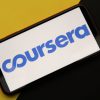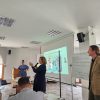On March 11th, 2010, the School of Humanities and Social Sciences’ Educational Innovation Team hosted a campus-wide town hall meeting on “Uses of Technology to Improve Student Learning.” The meeting was well attended with faculty from all of AUI’s schools represented, including staff from the Center for Learning Technology (CLT).
The purpose of this “roundtable discussion-style” town hall meeting was to enable faculty to share with one another current innovative educational technologies that help improve teaching effectiveness and student learning in classroom settings, as well as adjunct uses of technology to increase student engagement. Those in attendance shared various tools and techniques that they personally utilized, and/or that they had become aware of, that may help in improving student engagement and learning.
Some of the various technologies discussed included:
1.) Use of DVD’s in the classroom, including PBS’ History of American Studies, which helped in making the history “come alive.” It was indicated that 7 or 8 one hour DVD videos could be placed on Jenzabar, accompanied by a list of questions that students would need to answer while watching the video presentations to keep them engaged.
2.) Use of TED lectures (www.TED.com), featuring some well-known individuals doing 15 to 20 minute lectures on many specialized topics, including many visual communication illustrations. These mini-lectures are fully transcribed, are sub-titled, and easily accessible via a searchable database. Students are asked to critically evaluate the material presented, and must list sources utilized/accessed to assist in the evaluation.
3.) In teaching Physics & Engineering, it was indicated that simulations of the subject phenomenon were invaluable to help in students understanding of the concepts.
4.) In the business school, it was indicated that an effective technique was to type a word depicting a concept, do a 10 minute mini-lecture, transcribe it in the native language, and then make it searchable in a database.
5.) In teaching psychology, they utilize the combination of a live demonstration accompanied by a video to teach a chapter on “memory.”
6.) In teaching geography and anthropology it was indicated that IDRISI was utilized. IDRISI is an integrated geographic information system (GIS) and remote sensing software developed by Clark Labs at Clark University, and helps to make the topic interactive, thus encouraging student engagement.
7.) It was indicated that new Rich Media videos are now available that have fully searchable sub-titles and can be presented in multiple languages on a range of subjects.
8.) The International Monetary Fund (IMF.org) also has a training institute and online learning modules that can help in teaching financial concepts.
9.) A program called “NetVibes” (netvibes.com) that can integrate various RSS feeds from multiple web sources, was also discussed. More details on the use of this technology were provided in a series of hands-on workshops, called “Technology for Global Learning: an Introduction to Tools and Pedagogies” that was jointly presented by SHSS’ Educational Innovation Team and the Center for Learning Technology in April. Other important uses of social media, real time collaboration, and audio/video web-mapping were discussed in those various seminar modules which were simultaneously streamed on the Internet and also archived for accessibility of those unable to attend. Go to clt.aui.ma for access.
There was also a vibrant discussion on the availability of faculty to utilize the resources of the Center for Learning Technology, including: 1.) Receiving additional training on Jenzabar; 2.) Doing lectures in CLT’s multi-camera studio that can then be archived and posted to Jenzabar; And 3.) The ability for instructors to give tests and quizzes via Jenzabar.
Other important topics discussed included: 1.) The possible utilization of programs like Tegrity (tegrity.com), that provide a cloud-powered, campus-wide lecture capture to help improve academic achievement and enable synchronous and asynchronous access to lectures for those who are unable to be present “in-person.” This technology would also enable student review of lectures to further learning and retention; And 2.) The need to have better rich media digital technology to capture live (via multiple-camera, television-style productions including titles, effects, & transitions) all of the great lectures, workshops, visitors, and events that take place here on the AUI campus, and be able to share these events with larger global academic audiences via Internet streaming, and via archiving and downloading these lectures given adequate Internet bandwidth at AUI.




